Garages are often overlooked when assessing the overall security of your house. If you’re looking for advice on improving the security of your garage, read our ultimate guide to garage door security. This following post has more of a focus on garage door locks, including common lock types, how they operate and our recommendations but is a great place to start when considering garage door security ideas.
Garage door locks explained
Digital, keyless and automatic locking systems
In one form or another, digital, keyless locking systems are available for both the main vehicle entry door or a side pedestrian garage door. The locking system usually requires either a fingerprint, multiple fingerprints, a pin code or a remote control to open it.
Vehicle entry doors will be connected to a motor in which the lock is situated in the gears itself making it difficult to tamper with or get access to. For pedestrian doors, the lock usually ensures the handle stays in place and/or bolts fasten the door into the door frame.
Pros:
- Most automatic systems can be configured to automatically lock when closed or left unlocked for a set amount of time.
- Multi-point locking mechanisms are possible, offering increased security. Automating the process speeds up locking and unlocking.
- Normally much easier to use and less risk of losing the key.
Cons:
- Automatic systems require professional installation.
- Adjusting an automatic system yourself can affect the manufacturer’s warranty.
- May require servicing costs (especially for vehicle entry doors).
If you opt for a pin code lock, ensure that the code is changed from the manufacturer’s default and that it is challenging to guess. For example, avoid using your date of birth.
Changing the pin code frequently is best practice for optimal security.
Locks For Vehicle Entry Garage Doors
T-handle or T-bar locks
T-handle locks, so-called due to the handle’s shape, consist of an external lock mechanism which doubles up as a handle to manually open and close the door from the outside. The inside of the garage door will feature a cable system with two bolts attached that secure into the door’s tracks. When a key is fitted into the lock cylinder and the t-handle is turned, the bolts are released. T-handle locks are typically found on single skin garage doors.
Found on:
These types of lock are normally fitted to single skin/standard up and over garage doors. We’d recommend adding additional locks to your door if it is solely relying on this.
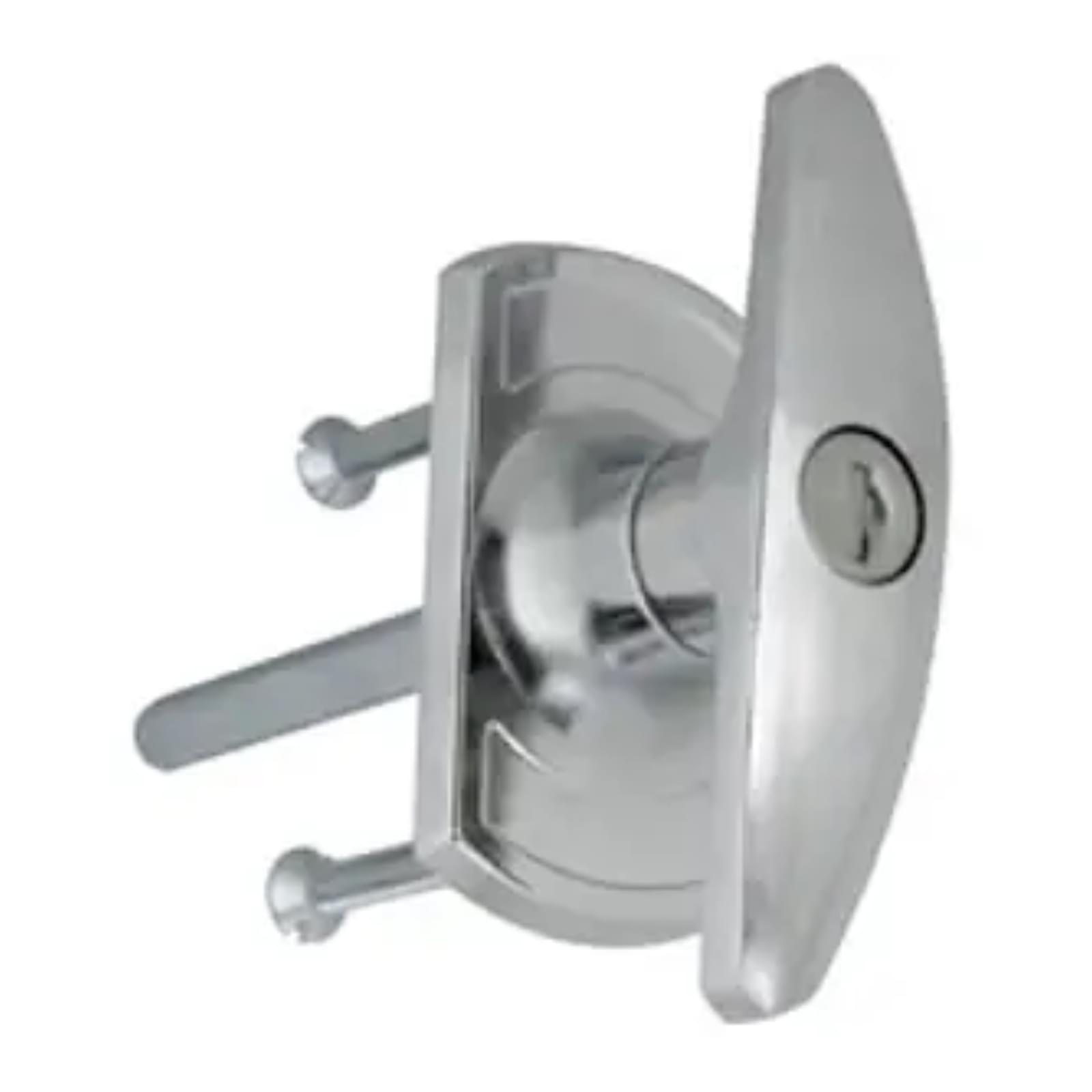
Pros:
- Inexpensive.
- Easy to fit yourself without professional help.
- Offers a convenient handle and lock to open and close the garage from the outside.
Cons:
- Vulnerable to brute-force attacks involving bashing or snapping the lock off the door, enabling burglars to access the garage.
- No protection against peeling or crowbar attacks targeting the bottom or sides of the door.
- Normally these locks are pretty easy to pick.
We recommend installing additional locks to secure the door to the ground, such as a garage door defender, and sliding bolts in the bottom corners.
Sliding drop or cane bolts
Sliding drop bolts are installed on the lower corners inside of the vehicle entry garage door. The metal bolt itself fits snugly into a slot drilled in the wall or the floor (called the ‘keep’) to hold it in place.
Found on:
These types of lock are usually found on gates, but can be fitted on most types of garage doors as an additional layer of security.
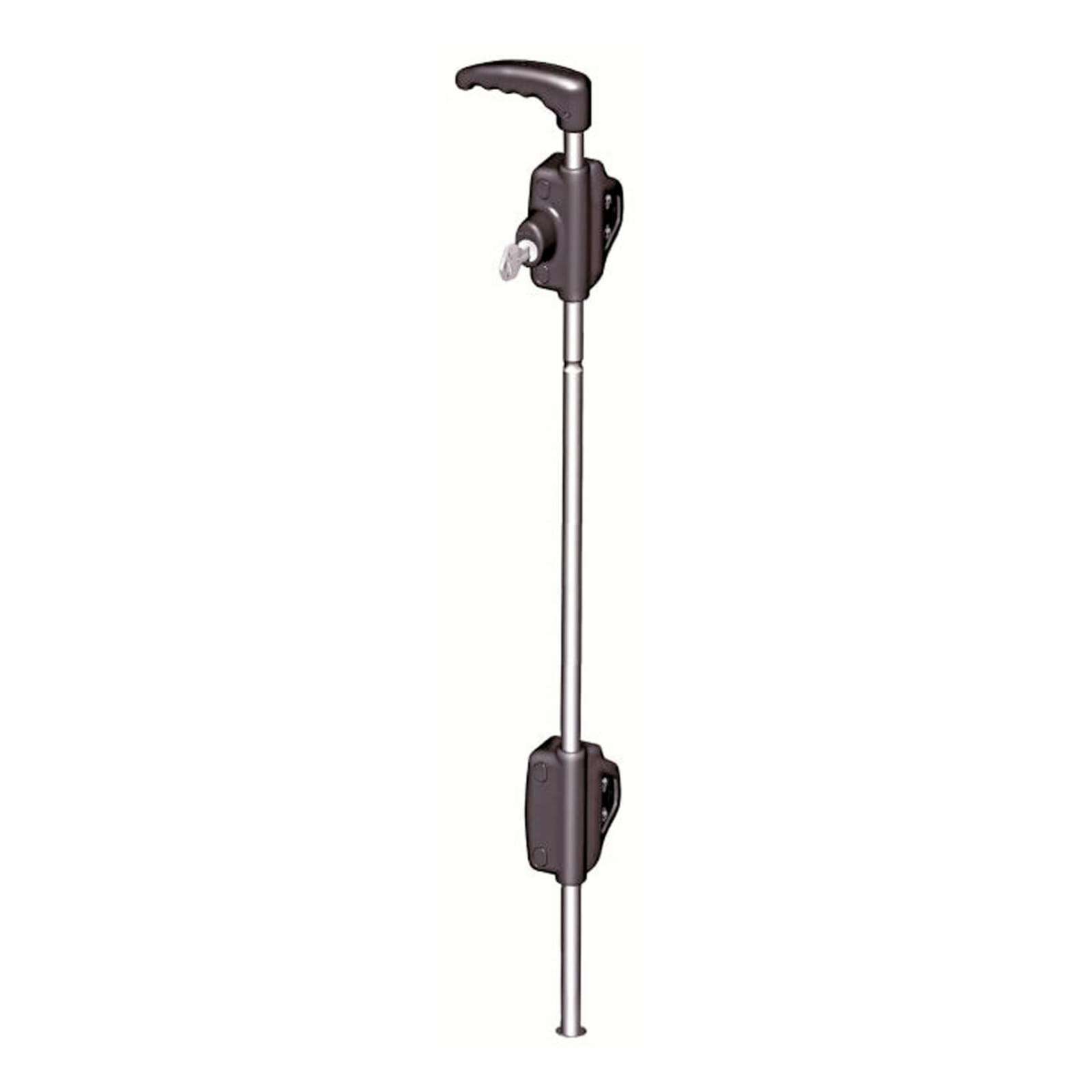
Pros:
- Sliding bolts make it harder for burglars to peel the door from the frame with a crowbar as the door is fixed within the frame.
- Inexpensive.
- Easy to install yourself.
- Inaccessible and invisible from outside.
- Multiple sliding bolts can be installed for extra strength.
- Can be used in conjunction with other locking systems. If they’re being used with an electric sectional door, however, extreme caution needs to be exercised to ensure the door is not operated with the locks in place.
Cons:
- When locked using the sliding bolts, the garage door cannot be accessed from outside – pedestrian access, or access via a property, is required
- Bolt keep requires a hole drilled into a plate in the ground.
Ground Locks
These locks fasten the bottom of the garage door (normally the T bar) into the ground via a padlock or something similar making it difficult to jack up.
Found on:
These types of lock are normally fitted to roller shutter doors (manual or electric).
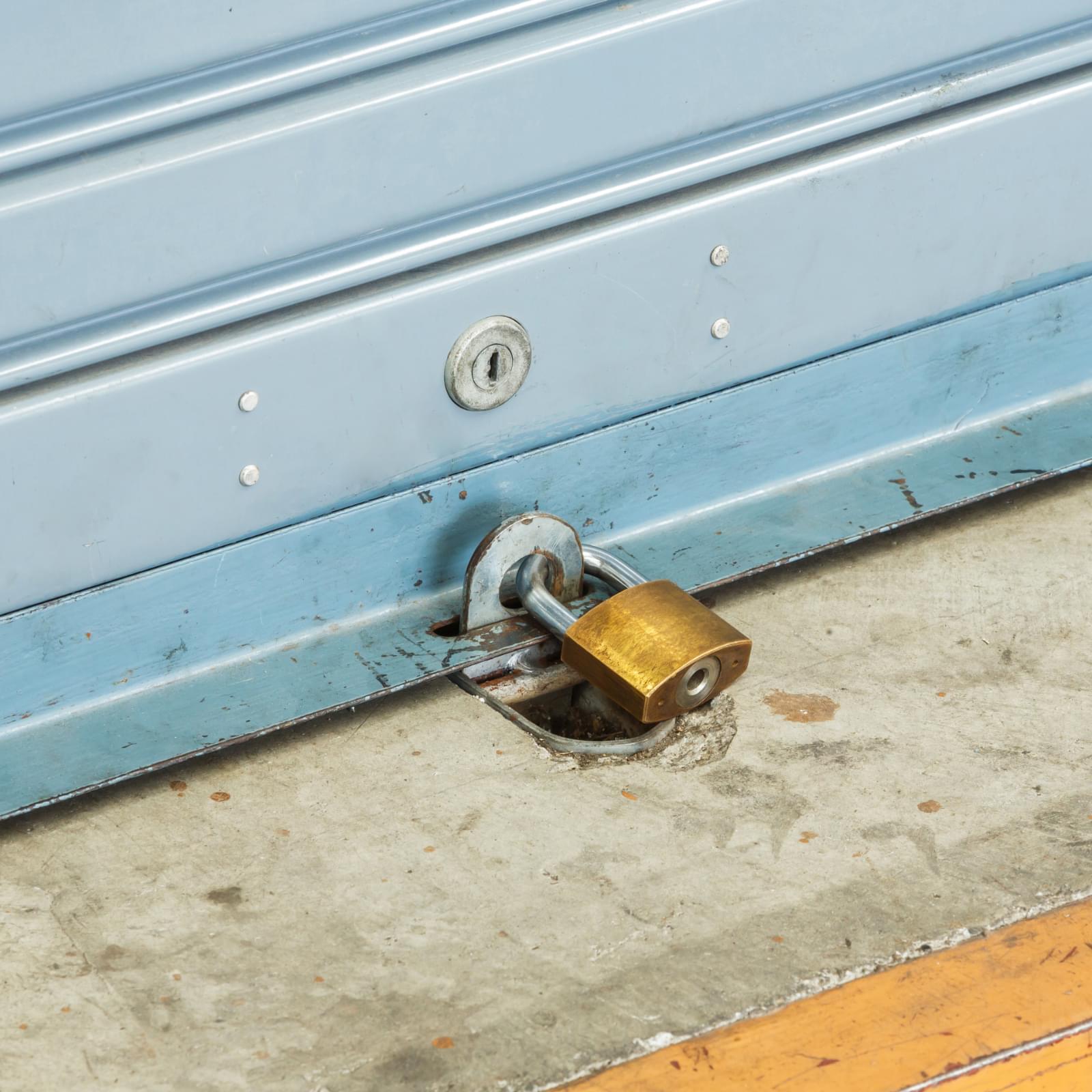
Pros:
- Inexpensive.
- Easy to install yourself.
- Stops the doors being jacked up via a crow bar or car jack.
Cons:
- Depending on the ground lock, it may be easy to bolt cut off or pick (although you may consider a garage door defender to mitigate against this – see below).
- If you have an electric garage door, you’ll need to remember to take the lock out before you run the door otherwise you’ll cause significant damage to the motor (although you can purchase lock isolators to stop this from happening).
- Space is required outside the garage to instal the defender. This may get in the way of a vehicle on your driveway, for example.
Bullet/Pin Locks
Normally found on roller shutters, pin locks fit through the shutter curtain and into the guide rails preventing the shutter from being forced upwards. They’re normally locked and unlocked via a key.
Found on:
These types of lock are normally fitted to roller shutter doors (manual or electric).
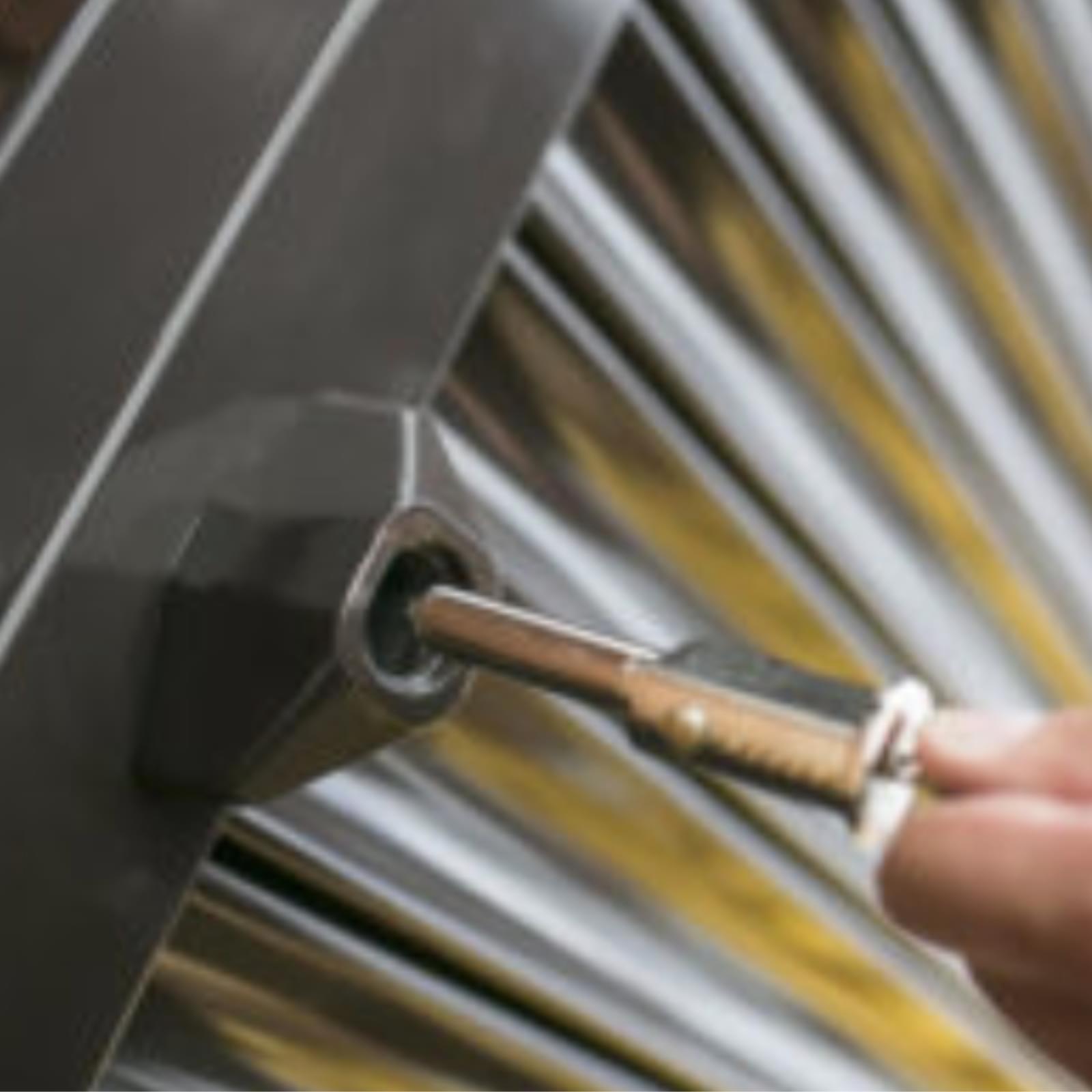
Pros:
- Inexpensive.
- Stops the doors being jacked up via a crow bar or car jack.
Cons:
- If they’re fitted on the inside, it means you’ll only be able to open the door internally.
- You’ll need a welder to install these yourself.
- If you have an electric garage door, you’ll need to remember to take the lock out before you run the door otherwise you’ll cause significant damage to the motor (although you can purchase lock isolators to stop this from happening).
Garage door defenders
Garage defenders are placed outside and immediately in front of the garage to secure the bottom of the garage door to the ground. A large arm is fixed to the door and locked into a concrete base with a padlock. The defender’s arm is on top of the base, restricting movement of the door.
Found on:
This type of lock can be fitted to most types of garage doors.
Pros:
- The padlock itself is shielded by the defender’s welded steel casing.
- They are designed to be a visual deterrent as well as a physical on.e
- A real challenge to break in a brute force attack.
Cons:
- Space is required outside the garage to instal the defender. This may get in the way of a vehicle on your driveway, for example.
- Can be costly.
This Squire GA5 garage door defender features an anti-pick design and is available for a reasonable price.
Locks Used On Pedestrian Garage Side Doors
Euro Cylinders
Euro cylinder locks are available in double and single cylinder designs, the former featuring key cylinders on both sides of the door.
Found on:
Euro Cylinders are typically fitted on uPVC, aluminium or steel garage personnel doors.
You can buy Euro cylinders from our sister website, Latham’s hardware, here
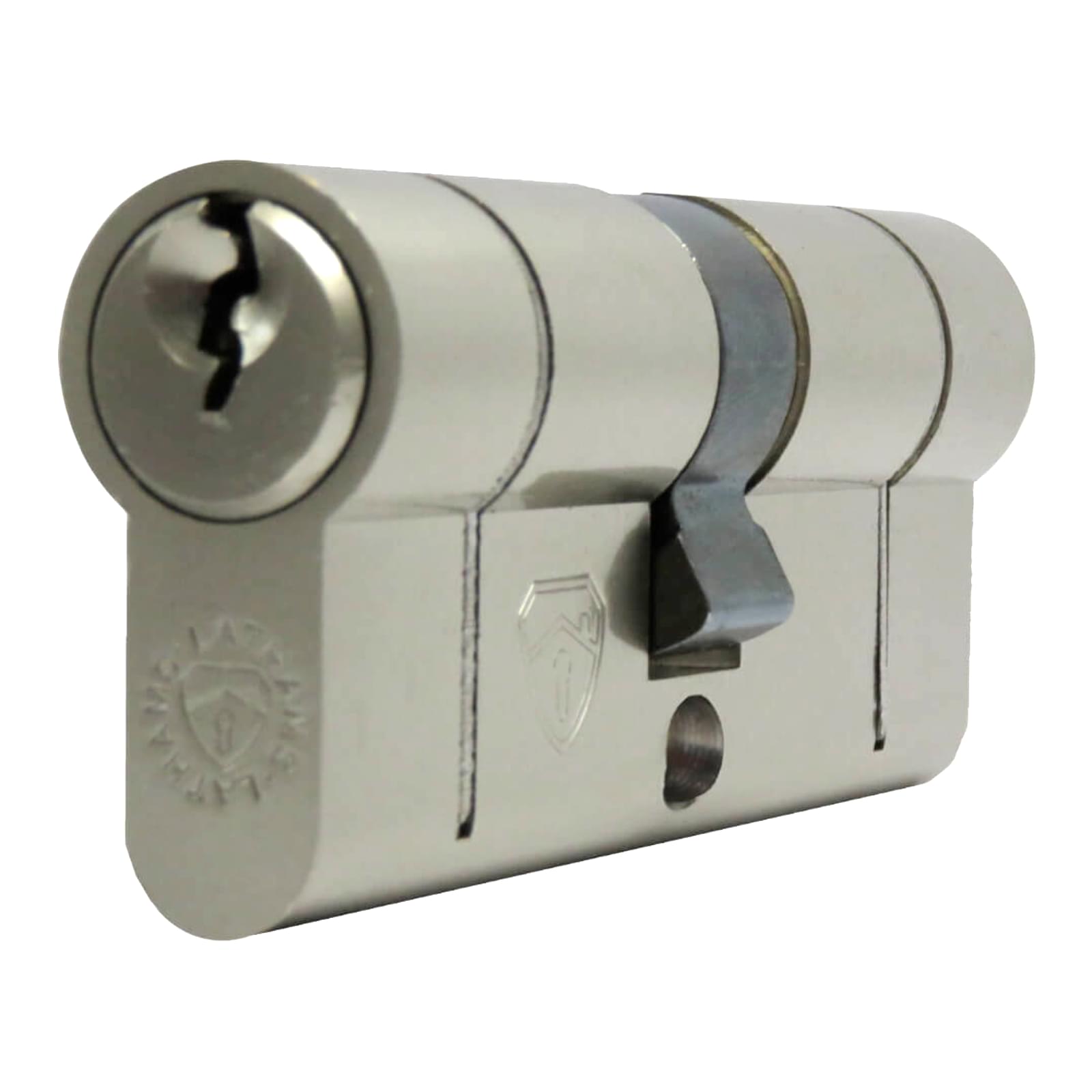
Pros:
- Available in keyed alike or standard differ variations.
- Suitable for steel, uPVC, wood or composite doors.
- Inexpensive.
- Easy to install yourself.
- Allows keyed access from both sides, or one side if you opt for a thumb turn variant.
- Not spring operated, making them harder to force open.
Cons:
- Euro Cylinders must be fitted correctly; it’s very easy to install one in a way which makes them easy to break into. If any part of the cylinder is exposed, it is vulnerable in brute-force attacks.
Ensure that your euro cylinder has anti-bump, anti,drill, anti-pick and anti-snap properties. When purchasing the lock, this should be stated in the product’s description. For more information on euro cylinder locks, read this article on the perfect door lock.
Our sister company, Latham’s Hardware, provides quality anti-snap locks in a range of sizes.
Multi-Point Locking System
A multi-point locking system is key operated and fitted to the body of the door. When the key is turned, the door is bolted into the frame and locked at multiple points offering a higher level of security than a traditional single lock. The multi point system distributes the weight throughout 3, 5 or even 7 points and is therefore harder to break into.
Found on:
Multi-point locks are typically fitted on uPVC, aluminium or steel garage personnel doors. However, they can also be fitted to timber pedestrian doors.
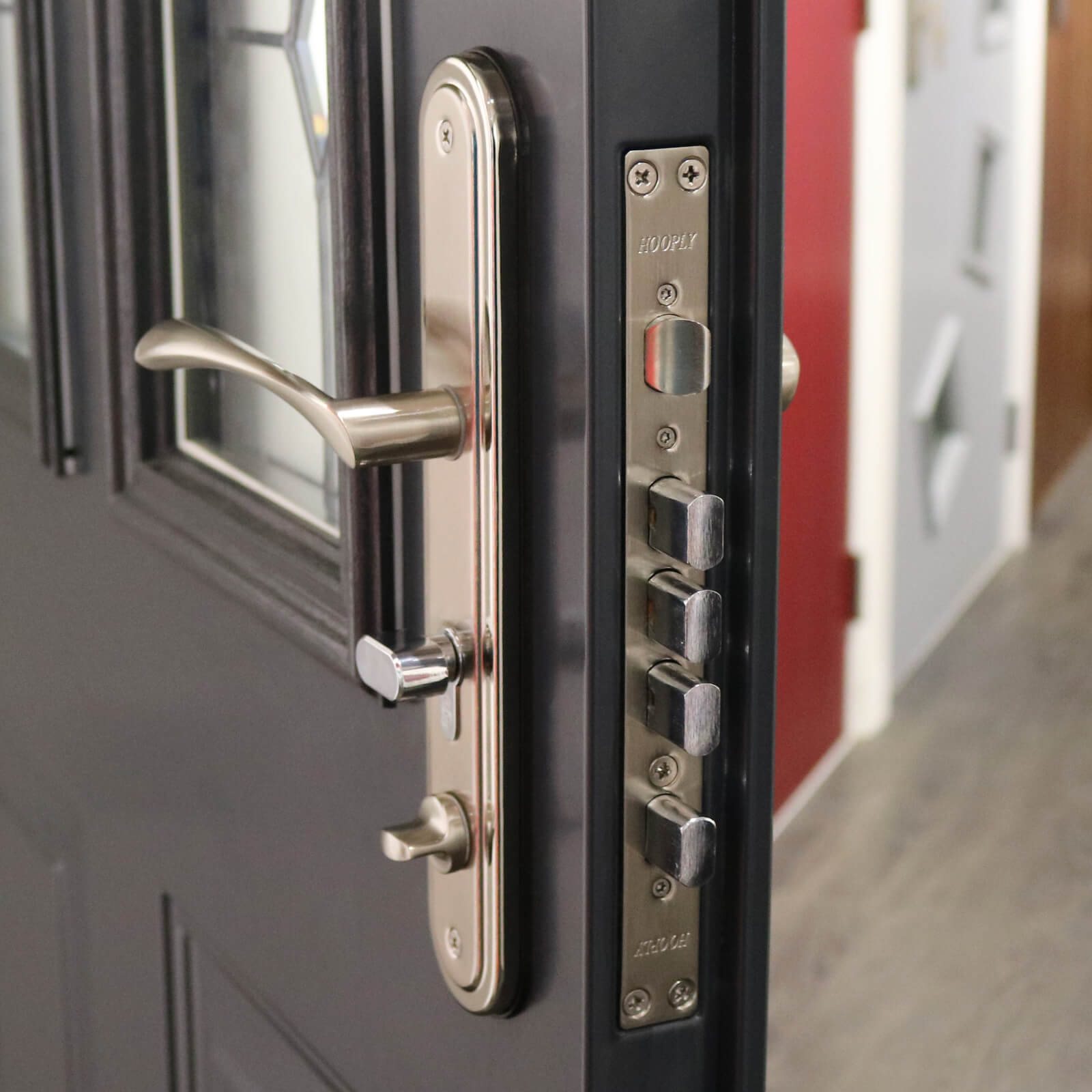
Pros:
- Available in keyed alike or standard differ variations.
- Suitable for steel, uPVC, aluminium or composite doors.
- Relatively inexpensive.
- Easy to install yourself if the door/frame allows.
- Only one cylinder is required to lock the full mechanism. It’s also easy to change/update the cylinder if required.
Cons:
- Depending on the door you currently have, you may need to replace the frame and/or the door to accommodate a multi-point locking system.
- You’ll have to remember to lift the handle when you’re locking the door so as to engage the complete mechanism. It’s relatively easy to not lock these types of systems properly.
A highly trusted brand of high quality multi locking systems are HOOPLY, for which Latham’s Steel Doors are a preferred supplier. You can purchase them here.
Mortice deadlocks
Mortice deadlocks are rebated inside the garage door itself, with a flush finish. These types of lock are not spring operated meaning you have to turn the key to ensure the door is locked/unlocked.
Mortice deadlocks usually come in two options; a 5 lever and 3 lever lock assembly. As expected, the 3 lever lock is less secure as it has fewer levers increasing the risk of key duplication. If you’re using one of these locks, to keep your garage door secure, we’d recommend nothing less than a 5 lever mortice deadlock. Furthermore, if budget allows, go for one that is BS3621 approved. This extra accreditation will mean the lock has a few additional security measures, such as hard plates to prevent drilling.
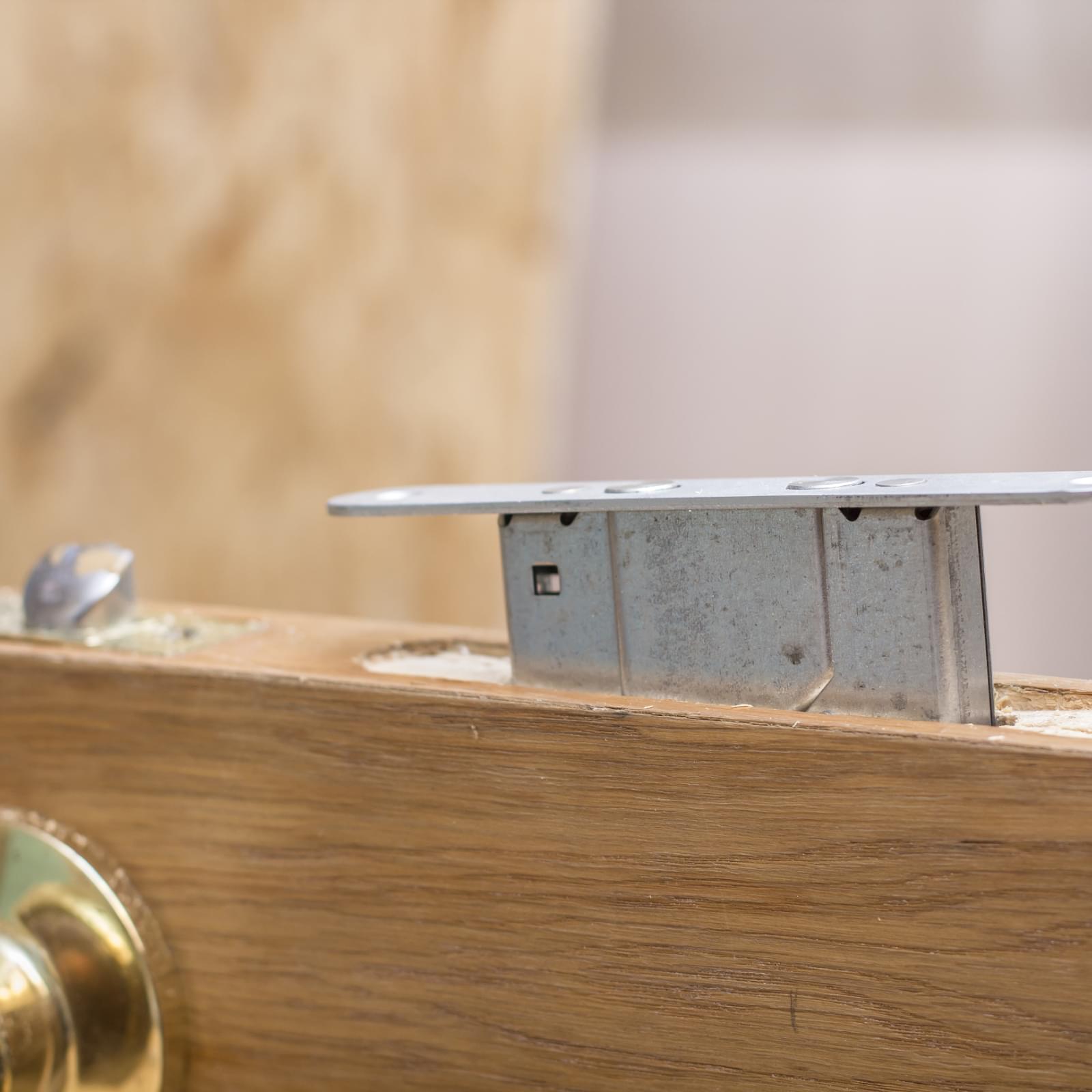
Pros:
- Modern 5-lever designs offer enhanced security as they are more challenging to pick, especially when accredited to BS3621.
- Allows keyed access from both sides.
- Not spring operated, making them harder to force open.
Cons:
- Only suitable for wooden doors.
- To fit the lock, a rectangular pocket may need to be chiseled or drilled out of the door.
A range of high-quality 5-lever mortice deadlock designs are available at Screwfix. Yale, Legge, ASEC and Chubb are among the top rated manufacturers for these types of lock.
What to Consider When Buying A Garage Door Lock
Level of Security
When deciding how much to invest in your garage door security, you should consider the value of items stored within and whether or not access to the rest of your property is available via the garage.
If you require a higher level of security, you may wish to use multiple locks, using the guide above to choose the most suitable depending on your garage door.
Durability, strength and weatherproofing
Most locks will be manufactured from stainless or galvanised steel so should be fairly corrosion-resistant. If you live near the seaside, or the lock you’ve bought is not from a reputable manufacturer, we’d recommend that your locks are regularly inspected to ensure they are undamaged.
Which lock should I buy?
The most secure locking systems should enhance or work to counteract any known vulnerabilities with the door’s design. The type of lock you should buy, therefore, very much depends on the type of door you have. Below is a brief summary of which lock you should use depending on the door that you have:
Pedestrian garage side doors
For wooden, steel, composite and uPVC pedestrian doors, you should opt for a single euro cylinder lock to ensure that a key is not required to exit in the event of a fire. However, for higher levels of security, we recommend fitting a key-operated multi-point locking system.
Main Vehicle Entry Garage Doors
Manual roller shutters
If you have a manual, spring operated manually operated shutter, in addition to the built-in lock that should already be present on the door, we’d recommend installing a pair of bullet locks and/or a ground lock for even greater security. If you had to choose just one though, we’d go with the bullet locks as they’re harder to break off.
Electric roller shutters
An electric roller shutter that has been installed internally will already be pretty secure as the lock is concealed within the gearing of the motor. If you wanted to add additional security, however, consider installing two bullet locks. We’d also recommend purchasing a pin lock isolator so that you mitigate against the risk of running the shutter whilst the locks are inside and damaging the motor.
Single skin up and over doors
In addition to the T-handle that is already likely installed, consider a padlock and latch bolting it to the side of the frame for an easy upgrade. Otherwise you may also consider a form of ground lock/garage door defender for increased security. You may also consider a sliding crane bolt type lock, but these may cause you more hassle as they can only be opened from the inside.
Side Hinged Garage Doors
If your door is a side hinged garage door, it has more in common with a side garage personnel door than a traditional garage door. Depending on the material of your side hinged garage door, different locks will vary in suitability. See next section below.

Side Garage Personnel Doors
Steel garage side door
If your side door is made from steel, it’ll already likely come with a euro cylinder fitted. Ensure the euro cylinder has anti bump, anti drill and anti pick features and is fitted correctly. If not, you’ll want to replace it. Here’s a great guide on euro cylinders if you need more information.
Otherwise, you may wish to upgrade your whole locking system to a multi locking point system, but you may need to change your door and frame for this.
Alternatively, replace the lock with a digital or other keyless lock for ease of use.
uPVC garage side door
As above, it’ll already likely come with a euro cylinder fitted. Ensure the euro cylinder has anti bump, anti drill and anti pick features and is fitted correctly. If not, you’ll want to replace it.
Wooden garage side door
You’ll likely already have a mortice deadlock in place. If it’s only a 3-lever mortice deadlock, consider upgrading to a 5-lever mortice deadlock. The number of levers should be stamped on the faceplate of the lock if it’s a decent manufacturer so you should be able to tell the difference. You may also consider doubling up with a night latch and rim cylinder for additional locking points.

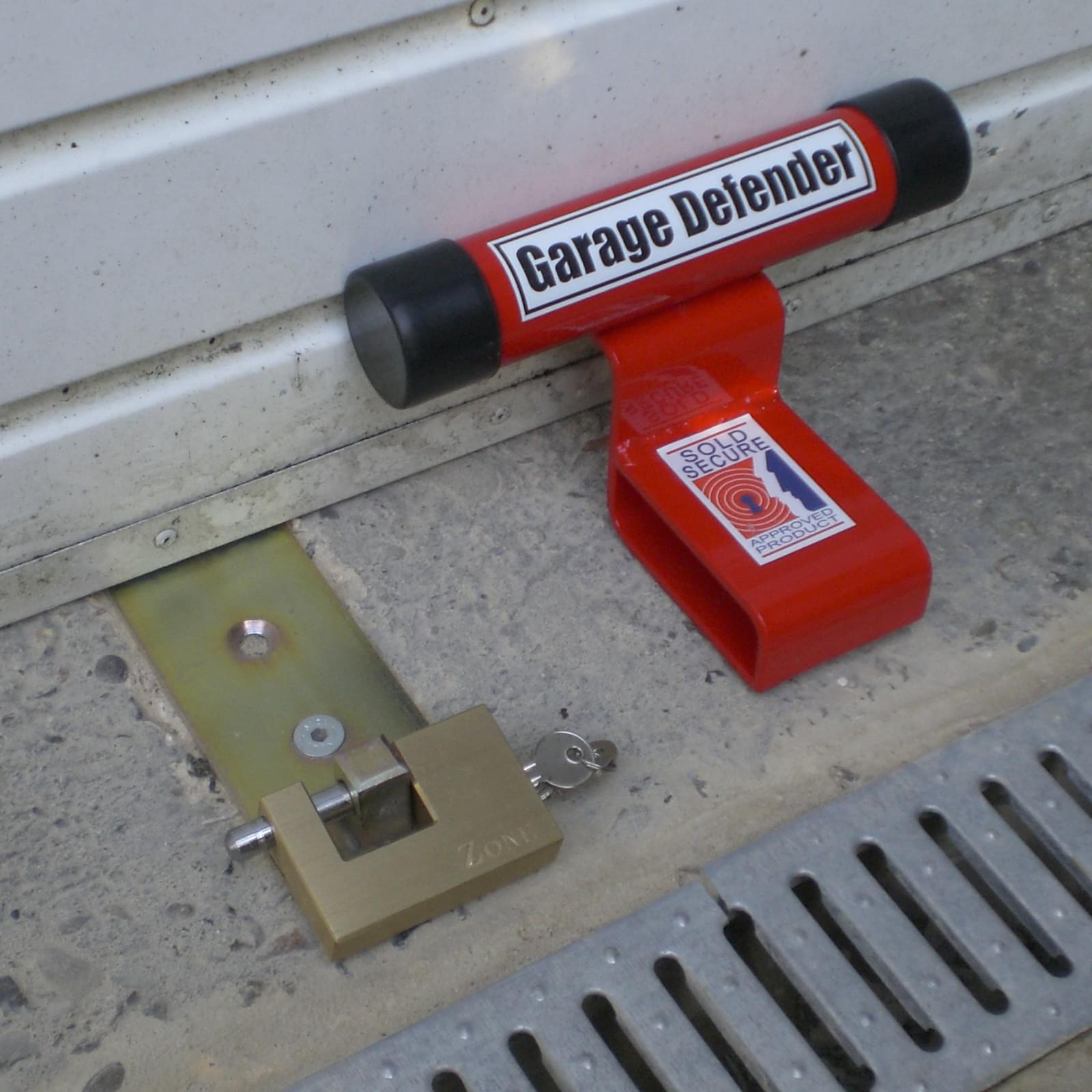
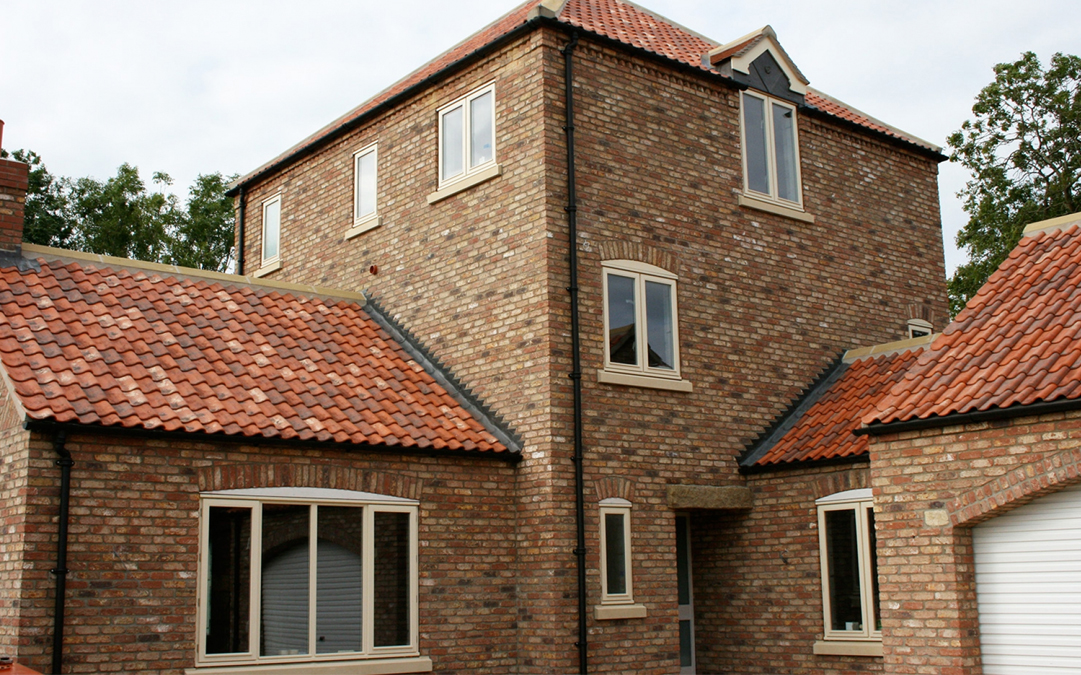

Pingback: The Benefits of Professional Garage Door Installation - SoCo Garage Door Services